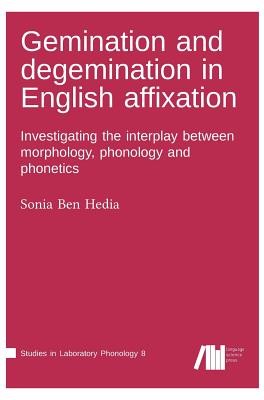
- We will send in 10–14 business days.
- Author: Sonia Ben Hedia
- Publisher: Language Science Press
- ISBN-10: 3961101892
- ISBN-13: 9783961101894
- Format: 17 x 24.4 x 2.1 cm, kieti viršeliai
- Language: English
- SAVE -10% with code: EXTRA
Gemination and degemination in English affixation (e-book) (used book) | bookbook.eu
Reviews
Description
In English, phonological double consonants only occur across morphological boundaries, for example, in affixation (e.g. in unnatural, innumerous). There are two possibilities for the phonetic realization of these morphological geminates: Either the phonological double is realized with a longer duration than a phonological singleton (gemination), or it is of the same duration as a singleton consonant (degemination). The present book provides the first large-scale empirical study on the gemination with the five English affixes un-, locative in-, negative in-, dis- and -ly. Using corpus and experimental data, the predictions of various approaches to the morpho-phonological and the morpho-phonetic interface are tested. By finding out which approach can account best for the gemination pattern of English affixed words, important implications about the interplay between morphology, phonology and phonetics are drawn.
EXTRA 10 % discount with code: EXTRA
The promotion ends in 22d.15:49:17
The discount code is valid when purchasing from 10 €. Discounts do not stack.
- Author: Sonia Ben Hedia
- Publisher: Language Science Press
- ISBN-10: 3961101892
- ISBN-13: 9783961101894
- Format: 17 x 24.4 x 2.1 cm, kieti viršeliai
- Language: English English
In English, phonological double consonants only occur across morphological boundaries, for example, in affixation (e.g. in unnatural, innumerous). There are two possibilities for the phonetic realization of these morphological geminates: Either the phonological double is realized with a longer duration than a phonological singleton (gemination), or it is of the same duration as a singleton consonant (degemination). The present book provides the first large-scale empirical study on the gemination with the five English affixes un-, locative in-, negative in-, dis- and -ly. Using corpus and experimental data, the predictions of various approaches to the morpho-phonological and the morpho-phonetic interface are tested. By finding out which approach can account best for the gemination pattern of English affixed words, important implications about the interplay between morphology, phonology and phonetics are drawn.


Reviews